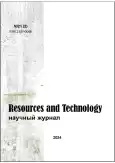Multi-purpose optimization of parameters of the plow combined body
- Autores: Zimarin S.V.1, Chetverikova I.V.1, Khripchenko M.S.1
-
Afiliações:
- Voronezh State University of Forestry and Technologiesnamed after G. F. Morozov
- Edição: Volume 21, Nº 2 (2024)
- Páginas: 83-101
- Seção: Articles
- URL: https://bakhtiniada.ru/2307-0048/article/view/349882
- DOI: https://doi.org/10.15393/j2.art.2024.7484
- ID: 349882
Citar
Texto integral
Resumo
The article substantiates the optimal technological parameters of the plow combined body used for basic tillage. As part of the rational energy-saving technology of reforestation, the proposed plow body will be included in the design of multifunctional tools that allow for high-quality tillage in uncleared stands. The process of high-quality tillage includes a full turn of a soil layer and its laying next to an open furrow with the highest possible preservation of the layer’s integrity. Experimental studies have been performed to determine the main characteristics of assessing the quality of tillage with the proposed tool, in particular, the rotation of the soil layer and its deformation coefficient, as well as the longitudinal and transverse displacement of the soil mass. The authors determined the dependences of the rotation angle of the soil layer, the coefficient of its deformation and the longitudinal and transverse displacement of the soil mass on three main technological parameters of the tool, such as: the approach angle and the angle of inclination of the disk housing, and the turning angle of the plow moldboard. It has been established that the approach angle has the greatest influence on the above-mentioned characteristics of the plow, the angle of inclination of the disk housing has a less significant effect, and the turning angle of the plow moldboard has a very insignificant effect on the characteristics of the plow. It has been found that in this case, the approach angle and the angle of inclination of the disk housing have a contradictory effect on the treatment process. For example, an increase in the approach angle and a decrease in the angle of inclination of the disk housing increase the turnover of the soil layer while reducing its safety. In this work, the original goal set by the authors has been achieved: to study the process of turnover and deformation of the soil layer by the forest plow body and to determine its optimal parameters that affect high-quality of tillage. Regression models have been obtained that allow determining the optimal technological parameters of the plow combined body, namely: the approach angle 360, the angle of inclination of the disk body 150, the moldboard turning angle 200.
Palavras-chave
Sobre autores
Sergey Zimarin
Voronezh State University of Forestry and Technologiesnamed after G. F. Morozov
Autor responsável pela correspondência
Email: sezimarin@yandex.ru
Irina Chetverikova
Voronezh State University of Forestry and Technologiesnamed after G. F. Morozov
Email: chivles@rambler.ru
Michael Khripchenko
Voronezh State University of Forestry and Technologiesnamed after G. F. Morozov
Email: at-conf@yandex.ru
Bibliografia
-
1. Зимарин С. В. Дисковый корпус плуга с гиперболоидным отвалом // Актуальные направления научных исследований XXI века: теория и практика. 2015. Т. 3, № 2-1 (13-1). С. 47—49. doi: 10.15393/j2.art.2016.3201. 2. Лягоскин М. А., Алиев Н. В., Дручинин Д. Ю. Особенности выполнения основной обработки почвы на вырубках // Молодой учёный. 2017. № 14 (148). С. 92—96. 3. Modeling of double action disc harrow draft force based on tillage depth and forward speed / I. Ranjbar, M. Rashidi, H. F. Lehmali [et al.] // Middle east journal of scientific research. 2013. Vol. 17, no. 8. P. 1061—1067. 4. Karmakar S., Kushwaha R. L. Simulation of soil deformation around a tillage tool using computational fluid dynamics // Transactions of the ASAE. 2005. Vol. 48, no. 3. P. 923—932. 5. Modeling the effect of weight and forward speed on the performance of disc plough / O. M. Olatunji, A. J. Akor, B. A. Ozogu [et al.] // Electronic Journal of Environmental, Agricultural and Food Chemistry. 2009. Vol. 8, no. 2. P. 130—149. Text. Image: electronic. 6. Sharifat K. Modeling soil movement by tillage tools // Canadian Biosystems Engineering. 2000. Vol. 42, no. 4. P. 165—172. 7. Патент на изобретение 2727834 C1, 24.07.2020 / С. В. Зимарин, М. В. Драпалюк, М. С. Хрипченко, И. В. Четверикова. Заявл. № 2019144354 от 24.12.2019. 8. Нартов П. С. Дисковые почвообрабатывающие орудия. Воронеж: Изд-во ВГУ, 1972. 181 с. 9. Chaudhary A. Testing of tillage implements: disc plough, mouldboard plough and disc harrow. 2019. doi: 10.13140/RG.2.2.25608.67840. 10. Evaluating the success of direct seeding for tropical forest restoration over ten years / M. G. Freitas [et al.] // Forest Ecology and Management. 2019. No. 438. P. 224—232. doi: 10.1016/j.foreco.2019.02.024. 11. Зимарин С. В., Четверикова И. В. К обоснованию параметров корпуса дискатора для нераскорчёванных вырубок // Resources and Technology. 2020. Т. 17, № 3. С. 97—110. doi: 10.15393/j2.art.2020.5382. 12. Зимарин С. В., Хрипченко М. С., Четверикова И. В. Исследование параметров новой конструкции мультиблока для ресурсосберегающего восстановления дубрав // Resources and Technology. 2022. Т. 19, № 2. С. 118—133. doi: 10.15393/j2.art.2022.6263. 13. Анализ дисковых рабочих органов лесных почвообрабатывающих орудий / С. В. Малюков, М. Н. Лысыч, Л. Д. Бухтояров [и др.] // Лесотехнический журнал. 2023. Т. 13, № 2 (50). С. 128—141. 14. Soil-cutting simulation and parameter optimization of rotary blade’s three-axis resistances by response surface method / G. Zhang, Z. Zhang, M. Xiao [et al.] // Computers and Electronics in Agriculture. 2019. Р. 164. 15. Laboratory studies of extinguishing a forest ground fire with soil / M. A. Gnusov, M. V. Drapalyuk, D. Yu. Druchinin [et al.] // AIP Conference Proceedings. Series 2: Proceedings of the II International Conference on Advances in Materials, Systems and Technologies, CAMSTech-II 2021. 2022. P. 030031. 16. Effect of soil preparation method on economic result of Norway spruce regeneration chain / K. Uotila K. [et al.] // Silva Fenn. 2010. Vol. 44, no. 3. P. 511—524.
Arquivos suplementares










